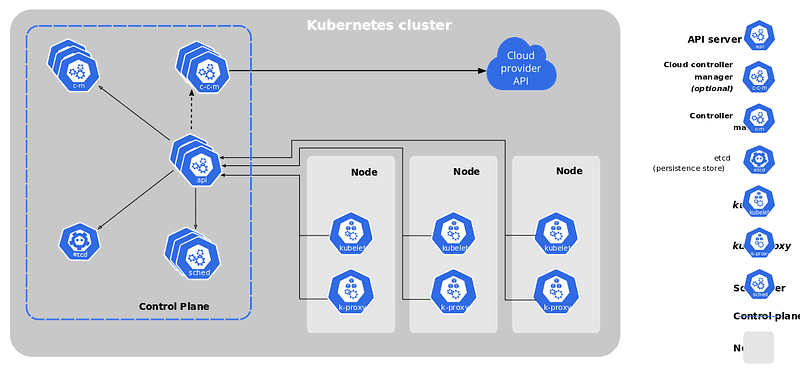Exploring Kubernetes Architecture: Part 1
 Vedant Adhe
Vedant AdheTable of contents
Introduction
Welcome to Day 02 of the #30DaysOfKubernetes challenge! On this exciting journey, we are unraveling the mysteries of Kubernetes Architecture, the open-source container orchestration engine that is revolutionizing the way we deploy and manage applications. In our quest to master Kubernetes, we’ll venture deeper into its inner workings, focusing on the critical components that make it all happen. So, buckle up for another day of discovery as we delve into the architecture of Kubernetes! Let’s begin!

Kubernetes Architecture By Kubernetes(Credit)
Kubernetes follows client-server architecture where the Master Node and Worker node exist which constitutes a ‘Kubernetes Cluster’. We can have multiple worker nodes and Master nodes according to the requirement.
Control Plane
The control plane components, including the API server, etcd, scheduler, and controller manager, are typically found on the master node(s) of a Kubernetes cluster. These components are responsible for managing and controlling the cluster as a whole.
Master Node
The master node is responsible for the entire Kubernetes cluster and manages all the activities inside the cluster in which master nodes communicate with the worker node to run the applications on the containers smoothly. Master Node has four primary components which help to manage all the things that we have discussed earlier:
API Server: In Simple terms, after installing the kubectl on the master node developers run the commands to create pods. So, the command will go to the API Server, and then, the API Server forwards it to that component which will help to create the pods. In other words, the API Server is an entry point for any Kubernetes task where the API Server follows the hierarchical approach to implement the things.
Etcd: Etcd is like a database that stores all the pieces of information of the Master node and Worker node(entire cluster) such as Pods IP, Nodes, networking configs, etc. Etcd stored data in key-value pair. The data comes from the API Server to store in etc.
Controller Manager: The controller Manager collects the data/information from the API Server of the Kubernetes cluster like the desired state of the cluster and then decides what to do by sending the instructions to the API Server.
Scheduler: Once the API Server gathers the information from the Controller Manager, the API Server notifies the Scheduler to perform the respective task such as increasing the number of pods, etc. After getting notified, the Scheduler takes action on the provided work.
Let’s understand all four components with a real-time example.
Master Node — Mall Management:
In a shopping mall, you have a management office that takes care of everything. In Kubernetes, this is the Master Node.
The Master Node manages and coordinates all activities in the cluster, just like mall management ensures the mall runs smoothly.
kube-apiserver — Central Control Desk:
Think of the kube-apiserver as the central control desk of the mall. It’s where all requests (like store openings or customer inquiries) are directed.
Just like mall management communicates with stores, kube-apiserver communicates with all Kubernetes components.
etcd — Master Records:
etcd can be compared to the master records of the mall, containing important information like store locations and hours.
It’s a key-value store that stores configuration and cluster state data.
kube-controller-manager — Task Managers:
Imagine having specialized task managers for different mall departments, like security and maintenance.
In Kubernetes, the kube-controller-manager handles various tasks, such as ensuring the desired number of Pods are running.
kube-scheduler — Scheduler Manager:
Think of the kube-scheduler as a manager who decides which employees (Pods) should work where (on which Worker Node).
It ensures even distribution and efficient resource allocation.
What’s Next?
Suspense Unveiled
I am a passionate DevOps enthusiast with a strong foundation in Linux, containerization, orchestration, automation, and cloud technologies. My goal is to continuously learn and implement DevOps best practices to streamline development and operations processes.
LinkedIn linkedin.com/in/vedant-adhe
GitHub (github.com/VedantAdhe)
Connect Vedantadhe04@gmail.com
!!!!!Thank you for reading !!!!!
Subscribe to my newsletter
Read articles from Vedant Adhe directly inside your inbox. Subscribe to the newsletter, and don't miss out.
Written by
